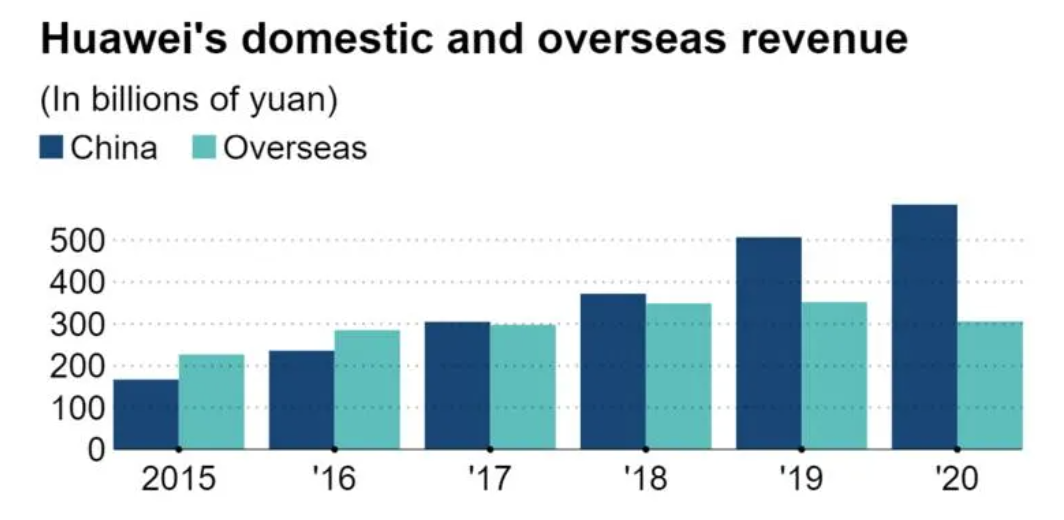China’s Huawei Technologies is betting on emerging markets to reinvigorate its overseas business, which at one time accounted for around 70% of its total revenue, as a US-led boycott of the company continues to cloud its outlook in Western markets.
In June, Senegal opened a EUR 70 million (USD 83 million) data center. Local media quoted President Macky Sall as saying at the opening ceremony that data from each province of the West African nation will go through the new facility. The center was built with a loan from the Chinese government, with Huawei supplying the telecom infrastructure.
The US is urging other nations to exclude Huawei products from fifth-generation wireless networks, citing national security concerns. But the telecoms equipment maker still has a dominant presence in emerging markets in Africa and the Middle East. Orders flow in because Huawei equipment is about 20% to 30% cheaper than those made by its European rivals such as Sweden’s Ericsson and Finland’s Nokia, with high functionality for the price. The company has not given up on expanding its business in developed countries but is focusing more on emerging markets, including Southeast Asia.
Huawei offers telecom equipment along with related systems to many countries. One of the company’s focuses is smart cities. As of the end of 2020, Huawei is believed to have engaged in smart city projects in more than 700 cities in 40 countries.
One such place is Dubai, where Huawei is involved in the construction of 5G infrastructure while providing “smart streetlights” embedded with security cameras and temperature sensors. The company has also supplied a system that combines 4G base stations and security cameras in Kenya, which it claims helps to cut crime. Demand for security cameras to deter crime is high, despite concerns that governments can obtain personal data from footage.

Behind Huawei’s aggressiveness is China’s Belt and Road Initiative. Though Huawei says its business has nothing to do with the government, many of the smart city projects in Africa and the Middle East regions covered by the initiative, receive Chinese government-backed loans, with the company being a beneficiary.
But many emerging economies are now saddled with ballooning debt to China, and some are struggling to repay them. The US and Europe have pointed to Beijing’s keenness to lend as “debt-trap diplomacy.” If emerging markets become wary, Huawei’s business in these regions could be hit.
US pressure is already working in advanced economies. Japan, Australia, and Britain have excluded Huawei from their 5G infrastructure. France and Germany have not clearly said so, but they are imposing measures that effectively make entry into the market difficult for the Chinese company. Sales of telecom equipment were robust until 2020, but Huawei is slowly losing its share to Nokia and other rivals.
Overseas sales accounted for almost 70% of the company’s total in the first half of the 2010s, but that figure fell to 34% in 2020. It now counts on much more on the domestic market, which makes up the rest. On top of US restrictions since 2019, Huawei seems to be increasingly relying on the domestic market for its smartphone and the growing 5G business.
“The Chinese market will account for an even larger part of Huawei’s sales. Overseas operations are susceptible to US-China relations and international situations,” said Tianfan Li, an analyst at securities company CSC International Holdings.
Huawei grew its business by aggressively expanding overseas from 1997. A little over 30 years since its establishment, it now employs nearly 200,000 people in more than 170 countries and territories. One of its challenges is whether it can continue to grow overseas and globalize its business.
Read more: Xiaomi is now the world’s largest smartphone manufacturer, here’s how it got there
Ren Zhengfei, the 76-year-old founder and CEO of the company, is a charismatic leader. Day-to-day operations are overseen by three “rotating” chairmen, but Ren’s leadership remains strong and he plays a key role in uniting the company.
Ren worked as an engineer in the People’s Liberation Army, then at a state-owned energy company. Eventually, he asked acquaintances to help him raise USD 3,000 in capital to establish the company in Shenzhen in 1987. In a 2019 interview with CNBC, Ren said he wanted to stay in his post until he can find a way for the company’s survival and growth, indicating that he would not be retiring anytime soon.
His daughter Meng Wanzhou, the company’s chief financial officer and prospective successor, faces US charges of breaking international sanctions against Iran. Her extradition hearing concluded Wednesday, Reuters reports. A Canadian judge is expected to rule on the case Oct. 21.
This article first appeared on Nikkei Asia. It’s republished here as part of 36Kr’s ongoing partnership with Nikkei.
